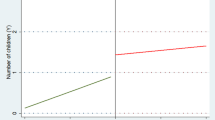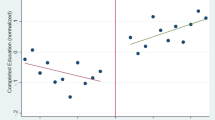Abstract
This study focuses on the causal effect of educational attainment on completed fertility for a cohort of Danish women born in 1963. The relationship between education and completed fertility (here defined as the number of children at age 41) is the result of a dynamic interplay between the two processes; in particular, educational attainment at a given time might be influenced by previous fertility. This notion is referred to as feedback from the fertility process to the education process. In this study population, feedback turns out to be present, and marginal structural models are used to construct a hypothetical population in which the feedback mechanisms are lifted out of the data. This gives rise to the conclusion that educational differences in completed fertility are to some degree attributable to feedback mechanisms and that they become smaller or are even reversed when this is taken into account. The study is based on data from individual-level, administrative registers.
Similar content being viewed by others
References
Andersson G, Rønsen M, Knudsen LB, Lappegård T, Neyer GR, Skrede K, Teschner K, Vikat A (2009) Cohort fertility patterns in the Nordic countries. Demogr Res 20(14):313–352
Barber JS (2001) The intergenerational transmission of age at first birth among married and unmarried men and women. Soc Sci Res 30:219–247
Becker GS, Tomes N (1976) Child endowments and the quantity and quality of children. J Polit Econ 84:S143–S162
Berthoud R, Robson K (2001) The outcomes of teenage motherhood in Europe. Innocenti Working Papers 86, UNICEF Innocenti Research Centre
Billari FC, Philipov D (2004) Education and the transition to motherhood: a Comparative analysis of Western Europe. European Demographic Research Papers 2004-3, Vienna Institute of Demography of the Austrian Academy of Sciences
Black SE, Devereux PJ, Salvanes KG (2005) The more the merrier? The effect of family size and birth order on children’s education. Q J Econ 120:669–700
Blossfeld H, Huinink J (1991) Human capital investments or norms of role transition? How women’s schooling and career affect the process of family formation. Am J Sociol 97(1):143–168
Breen R, Jonsson JO (2005) Inequality of opportunity in comparative perspective: recent research on educational attainment and social mobility. Annu Rev Sociol 31:223–243
Brewster K, Rindfuss R (2000) Fertility and women’s employment in industrialized nations. Annu Rev Sociol 26:271–296
Cohen JE, Kravdal Ø, Keilman N (2011) Childbearing impeded education more than education impeded childbearing among Norwegian women. Proc Natl Acad Sci 108:11830–11835
Cole SR, Frangakis CE (2009) The consistency statement in causal inference: a definition or an assumption? Epidemiology 20(1):3–5
Cole SR, Hernán MA (2008) Constructing inverse probability of treatment weights for marginal structural models. Am J Epidemiol 168:656–664
Diggle PJ, Heagerty P, Liang K-Y, Zeger SL (2002) Analysis of longitudinal data, 2nd edn. Oxford statistical science series. Oxford University Press, Oxford
Downey DB (1995) When bigger is not better: family size, parental resources, and children’s educational performance. Am Sociol Rev 60:746–761
Gerster M (2009) Socioeconomic determinants for fertility. PhD thesis, University of Copenhagen
Gerster M, Keiding N, Knudsen LB, Strandberg-Larsen K (2007) Education and second birth rates in Denmark, 1981–1994. Demogr Res 17:181–202
Gustafsson S (2001) Optimal age at motherhood. Theoretical and empirical considerations on postponement of maternity in Europe. J Popul Econ 14:225–247
Harrell FJ (2001) Regression modeling strategies: with applications to linear models, logistic regression, and survival analysis. Springer, Berlin
Hernán MA, Robins JM (2006) Estimating causal effects from epidemiological data. J Epidemiol Community Health 60(7):578–586
Hernán MA, Brumback B, Robins JM (2000) Marginal structural models to estimate the causal effect of Zidovudine on the survival of HIV-positive men. Epidemiology 11(5):561–570
Hernán MA, Brumback B, Robins JM (2001) Marginal structural models to estimate the joint causal effect of nonrandomized treatment. J Am Stat Assoc 96:440–448
Hoem JM, Prskawetz A, Neyer G (2001) Autonomy or conservative adjustment? The effect of public policies and educational attainment on third births in Austria, 1975–96. Popul Stud 55(3):249–261
Hoem JM, Neyer G, Andersson G (2006) Education and childlessness. The relationship between educational field, educational level, and childlessness among Swedish women born in 1955–59. Demogr Res 14:331–380
Hoem JM, Neyer G, Andersson G (2006) Educational attainment and ultimate fertility among Swedish women born in 1955–59. Demogr Res 14:381–404
Hotz VJ, McElroy SW, Sanders SG (2005) Teenage childbearing and its life cycle consequences. exploiting a natural experiment. J Hum Resour 40(3):683–715
Jager MM (2008) Do large sibships really lead to lower educational attainment? New evidence from quasi-experimental variation in couples’ reproductive capacity. Acta Sociol 51:217–236
Knudsen L (2002) An overview of recent fertility trends and family policies in Denmark. In: Nordic demography: trends and differentials, pp 131–156
Köppen K (2006) Second births in Western Germany and France. Demogr Res 14:295–330
Kravdal Ø(2001) The high fertility of college educated women in Norway. Demogr Res 5:187–215
Kravdal Ø(2002) Is the previously reported increase in second- and higher-order birth rates in Norway and Sweden from the mid-1970s real or a result of inadequate estimation methods? Demogr Res 6:241–260
Kravdal Ø(2007) Effects of current education on second- and third-birth rates among Norwegian women and men born in 1964: substantive interpretations and methodological issues. Demogr Res 17:211–246
Kuss O, McLerran D (2007) A note on the estimation of the multinomial logistic model with correlated responses in SAS. Comput Methods Programs Biomed 87:262–269
Lappegård T, Rønsen M (2005) The multifaceted impact of education on entry into motherhood. Eur J Popul 21:31–49
Liefbroer A, Corijn M (1999) Who, what, where, and when? Specifying the impact of educational attainment and labour force participation on family formation. Eur J Popul 15:45–75
Naz G, Nielsen ØA, Vagstad S (2006) Education and completed fertility in Norway. In: Gustafsson S, Kalwij A (eds) Education and postponement of maternity—economic analyses for industrialized countries. European studies of population, vol 15. EAPS, Springer, Berlin
Ní Bhrolcháin M, Beaujouan É (2012) Fertility postponement is largely due to rising educational enrolment. Popul Stud 66:311–327
OECD (2002) Employment outlook
OECD (2009) Education at a glance 2009. OECD Indicator
Pearl J (2010) On the consistency rule in causal inference. Epidemiology 21(6):872–875
Pylkkänen E, Smith N (2004) The impact of family-friendly policies in Denmark and Sweden on mothers’ career interruptions due to childbirth. Discussion Paper IZA DP No 1050, IZA—Institute for the Study of Labor
Regnier-Loilier A (2006) Influence of own sibship size on the number of children desired at various times of life. The case of France. Population (English Edition) 61:165–194
Rindfuss RR, Brewster KL (1996) Childrearing and fertility. Popul Dev Rev 22:258–289
Rindfuss RR, St John C (1983) Social determinants of age at first birth. J Marriage Fam 45(3):553–565
Rindfuss RR, Bumpass L, St John C (1980) Education and fertility: implications for the roles women occupy. Am Sociol Rev 45:431–447
Rindfuss RR, St John C, Bumpass LL (1984) Feedback. Education and the timing of motherhood: disentangling causation. J Marriage Fam 46:981–984
Rindfuss RR, Morgan SP, Offutt K (1996) Education and the changing age pattern of American fertility: 1963–1989. Demography 33:277–290
Robins J, Hernán M, Brumback B (2000) Marginal structural models and causal inference in epidemiology. Epidemiology 11(5):550–560
Rosenzweig M, Wolpin K (1980) Testing the quantity-quality fertility model: the use of twins as a natural experiment. Econometrica 48:227–240
Sampson RJ, Laub JH, Wimer C (2006) Does marriage reduce crime? A counterfactual approach to within-individual causal effects. Criminology 44:465–508
SAS Institute Inc (1999) SAS/STAT software
Simonsen M (2010) Price of high-quality daycare and female employment. Scand J Econ 112(3):570–594
Thygesen LC, Knudsen LB, Keiding N (2005) Modelling regional variation of first-time births in Denmark 1980–1994 by an age-period-cohort model. Demogr Res 13:573–596
Upchurch D, Lillard L, Panis C (2002) Nonmarital childbearing: influences of education, marriage, and fertility. Demography 39:311–329
Van Bavel J (2010) Choice of study discipline and the postponement of motherhood in Europe: the impact of expected earnings, gender composition, and family attitudes. Demography 47:439–458
Zangenberg CU, Zeuthen HE (1997) Den hvide hue. Hvad fører den til? Danmarks Statistik
Acknowledgements
We are grateful for the very helpful comments and suggestions we have received from Esben Budtz-Jørgensen from the University of Copenhagen, Øystein Kravdal from the University of Oslo, and Gerard van den Berg from the University of Mannheim. Also, earlier drafts of the paper have been presented at several seminars and conferences. In particular, the authors would like to thank our colleagues at the Stockholm University Demography Unit and the Population Studies Center at University of Pennsylvania for commenting on presentations of this material. Ulla Mogensen helped importantly in the technical preparation of the manuscript.
Author information
Authors and Affiliations
Corresponding author
Appendix
Appendix
1.1 A.1 Multinomial Logit Models for the Weights
We use a multinomial logistic regression model in which, year by year, we model the probability of either being enrolled in a certain education or having finished a given education, i.e. the probability of belonging to one of the educational categories which are used for the education variable in Model (3). Let π ikt be the probability that the ith woman belongs to education category k, k=1,…,8 in year t, i.e.
where k denotes one of the 8 categories described previously. Hence, the two models are
and
corresponding to the numerator and the denominator in the factor for year t entering into the weight for subject i, cf. Eq. (4). As a time-dependent covariate, we include age as a restricted cubic spline, and we furthermore include the indicator of having given birth in the year before, B i (t−1), and the indicator of having given birth the two years before, B i (t−2). We use the SAS procedures PROC CATMOD and PROC GENMOD [32, 50] to estimate the parameters of this model.
Once the parameter estimates, \(\hat{\alpha}_{k}\), \(\hat{\beta}_{k}\), \(\hat{\gamma}_{k}\) and \(\hat{\delta}_{k1}\) and \(\hat{\delta}_{k2}\), k=2,…,8, are found, we can calculate \(\hat{\pi}_{ikt}\) and use these as building blocks for the estimated weights, \(\hat{\operatorname {SW}}_{i}(T+1)\), where T is the year 2004 in which the women reach the age 41.
Note that due to the already vast number of parameters in the model for the weights, we included no explicit conditioning on prior education history up to year t.
Rights and permissions
About this article
Cite this article
Gerster, M., Ejrnæs, M. & Keiding, N. The Causal Effect of Educational Attainment on Completed Fertility for a Cohort of Danish Women—Does Feedback Play a Role?. Stat Biosci 6, 204–222 (2014). https://doi.org/10.1007/s12561-013-9102-0
Received:
Accepted:
Published:
Issue Date:
DOI: https://doi.org/10.1007/s12561-013-9102-0




